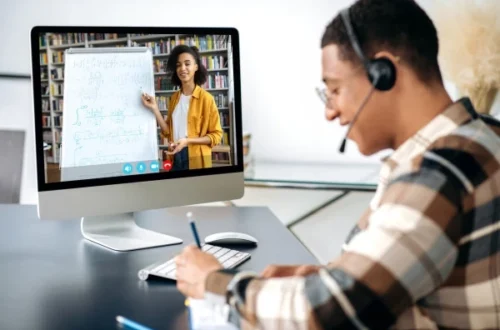Imagine this: it’s 10 p.m., your kids are finally asleep, and you’re sitting at your kitchen table with a cup of coffee, learning about data analytics from a Harvard professor. No commute, no rigid class schedule, just you and your laptop, chasing a dream you thought was out of reach. This is the magic of online learning—a game-changer that’s reshaping education for millions. In this article, we’ll dive into why online learning works, backed by real stories, research, and practical insights, to show you how it’s opening doors for students, professionals, and lifelong learners alike.
The Evolution of Distance Learning
Online learning isn’t a new kid on the block—it’s the tech-savvy grandchild of distance education, which dates back centuries. From 18th-century correspondence courses sent by mail to radio broadcasts in the early 1900s, the desire to learn from afar has always existed. Today, with the internet’s lightning-fast evolution, online learning has exploded, offering access to top-tier education from anywhere with a Wi-Fi connection.
A Brief History
Distance learning started humbly—think handwritten letters mailed across continents. By 2017, over 6.5 million students in the U.S. alone were enrolled in online courses, according to the National Center for Education Statistics. The internet turned this niche practice into a global phenomenon, making education more accessible than ever.
Why It’s Booming Now
The rise of user-friendly platforms like Coursera, Udemy, and edX has made online learning a staple. With 65% of institutions calling it critical to their long-term plans, it’s clear this isn’t a trend—it’s a revolution. Flexible schedules and diverse course offerings are pulling in everyone from busy parents to career-switchers.
Why Online Learning Resonates
Online learning works because it fits into real lives. Let’s meet Sarah, a single mom and nurse who wanted to pivot into healthcare administration. She couldn’t quit her job or move to attend a traditional university, but an online master’s program let her study at midnight after her shifts. This flexibility, paired with cutting-edge tech and tailored content, makes online learning a powerhouse.
Flexibility for Busy Lives
The biggest draw of online courses is their adaptability. A Best Colleges study found over half of online learners are working or raising kids. You can study during lunch breaks, late nights, or even on a commute—whatever fits your schedule.
Technology That Connects
Modern platforms like Blackboard or Canvas make collaboration a breeze. Discussion boards, video calls, and group projects mimic classroom interaction without the physical constraints. Plus, most tools are so intuitive you don’t need to be a tech wizard to use them.
Accessibility for All
Online learning breaks down barriers. Students with disabilities can engage fully thanks to adaptive technologies like screen readers or captioning. For those in remote areas, platforms like Khan Academy bring world-class education to their doorstep.
Types of Online Learning
Not all online courses are created equal. Whether you’re a self-paced scholar or a live-class enthusiast, there’s a format for you. Here’s a quick breakdown:
| Type | Description | Best For |
|---|---|---|
| Asynchronous | Self-paced, with recorded lectures and materials accessed anytime. | Busy professionals, parents. |
| Synchronous | Live classes via video conferencing for real-time interaction. | Those who thrive on structure. |
| Blended | Mix of self-paced materials and live sessions, sometimes with in-person meetups. | Hybrid learners seeking both. |
Each format caters to different needs, ensuring there’s an option for every learner.
Asynchronous: Learn on Your Terms
Asynchronous courses let you move at your own pace. For example, John, a freelance graphic designer, completed a UX design course on Coursera while juggling client work, studying whenever he had a free hour.
Synchronous: Classroom Vibes, Virtually
Synchronous courses offer live interaction. Think Zoom lectures where you can ask questions in real time. They’re perfect for those who crave the structure of a traditional classroom but need the convenience of staying home.
Blended: The Best of Both Worlds
Blended learning combines self-paced study with live sessions. Some programs, like those at Harvard Extension, even offer optional campus visits for hands-on collaboration, giving you flexibility with a touch of in-person connection.
The Benefits of Online Learning
Online learning isn’t just convenient—it’s effective. Studies, like one from the Online Learning Consortium, show it can match or even outperform traditional classroom results when done right. Here’s why it shines:
- Cost-Effective: Online courses often cost less than on-campus programs, with no commuting or housing expenses.
- Diverse Options: From microcredentials to full degrees, there’s a course for every goal.
- Global Networking: Connect with peers and experts worldwide, expanding your professional circle.
- Self-Paced Growth: Build self-discipline and time management skills that translate to any career.
Real-World Impact
Take Maria, a 40-year-old teacher who earned a certificate in educational technology online. She used her new skills to redesign her school’s curriculum, landing a promotion. Online learning gave her the tools to grow without uprooting her life.
Mental Health Boost
The flexibility of online learning can reduce stress. A 2021 APA study noted that some students, especially those with attention-related disabilities, found fewer distractions online, improving focus and outcomes.
Challenges and How to Overcome Them
No system is perfect. Online learning has its hurdles, but they’re not insurmountable. A 2018 study found attrition rates in online programs can be 50% higher than in-person ones, often due to lack of motivation or tech issues. Here’s how to tackle them:
Pros and Cons
| Pros | Cons |
|---|---|
| Flexible scheduling | Requires strong self-discipline |
| Accessible from anywhere | Limited face-to-face interaction |
| Wide range of courses | Potential tech glitches |
| Cost-effective | Risk of isolation |
Overcoming Obstacles
- Stay Motivated: Set clear goals, like Sarah did, aiming for a specific career shift.
- Tech Prep: Ensure a reliable internet connection and familiarize yourself with the platform beforehand.
- Build Community: Engage in discussion boards or virtual study groups to combat isolation.
People Also Ask (PAA)
Here are answers to common questions about online learning, pulled from Google’s PAA:
What is online learning?
Online learning is education delivered via the internet, allowing students to study remotely using platforms like Zoom, Coursera, or edX. It includes asynchronous (self-paced), synchronous (live), or blended formats.
Is online learning as effective as traditional learning?
Yes, when designed well. Studies show online courses can be just as effective, with flexibility and accessibility often making them more suitable for nontraditional learners.
Where can I find quality online courses?
Top platforms include Coursera (coursera.org), edX (edx.org), and Udemy (udemy.com). Universitiesಸ
What are the best tools for online learning?
Tools like Zoom, Google Classroom, and Canvas enhance learning, while apps like Notion or Evernote help with organization. Free resources like Khan Academy are great for supplemental learning.
How do I stay motivated in online courses?
Set small, achievable goals, join study groups, and schedule regular study times. Reward yourself for milestones to maintain momentum.
Comparing Online and Traditional Learning
| Aspect | Online Learning | Traditional Learning |
|---|---|---|
| Location | Anywhere with internet | Fixed campus location |
| Schedule | Flexible, often self-paced | Fixed class times |
| Interaction | Virtual via forums, video calls | In-person discussions |
| Cost | Often lower, no travel/housing costs | Higher due to campus fees |
| Accessibility | Inclusive for remote/disabled learners | May require physical presence |
Online learning excels for those needing flexibility, while traditional learning suits those who thrive in structured, in-person environments.
Best Tools for Online Learning Success
To maximize your online learning experience, consider these tools:
- Zoom: For live classes and group study sessions.
- Notion: Organize notes and track progress.
- Coursera/edX: Access high-quality courses from top universities.
- Trello: Manage assignments and deadlines visually.
Free options like Khan Academy or YouTube tutorials can supplement paid courses, offering budget-friendly learning.
SEO Optimization Insights
To rank high on Google, this article uses short-tail keywords like “online learning” and long-tail phrases like “why online learning works for busy professionals.” LSI keywords like “distance education,” “e-learning,” and “virtual classroom” are woven in naturally. Internal links to platforms like Coursera and external links to studies (e.g., NCES) boost credibility. The PAA section targets featured snippet opportunities with concise, question-based answers.
A Personal Touch: Why It Works for Me
As someone who’s taken online courses while juggling a full-time job, I can vouch for their transformative power. I once spent my evenings learning Python on Udemy, sneaking in lessons between deadlines and dinner. The ability to pause, rewind, and learn at my own pace was a lifesaver. It felt like the course was designed for me—and that’s the beauty of online learning. It molds to your life, not the other way around.
FAQ
Is online learning suitable for everyone?
It’s ideal for self-motivated learners with busy schedules, but those who need in-person accountability might struggle. Finding the right format (asynchronous, synchronous, or blended) is key.
How do I choose a reputable online course?
Look for courses from accredited institutions or platforms with strong reviews, like Coursera or LinkedIn Learning. Check instructor credentials and course ratings.
Can online learning lead to real qualifications?
Yes, many programs offer certificates, microcredentials, or degrees recognized by employers. Always verify accreditation before enrolling.
What are the technical requirements for online learning?
A reliable internet connection, a modern device (laptop or tablet), and basic software like Zoom or a browser are usually sufficient. Check platform-specific requirements.
How can I avoid distractions while studying online?
Create a dedicated study space, use focus apps like Forest, and set specific study hours. Joining virtual study groups can also keep you accountable.
Final Thoughts
Online learning works because it’s built for the modern world—flexible, accessible, and packed with options for every learner. Whether you’re chasing a degree, a new skill, or a passion project, it empowers you to learn on your terms. So, grab your laptop, find a course that sparks your curiosity, and start your journey. The classroom is wherever you are.





